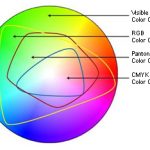If you’re a pro photographer or photo enthusiast, it’s likely that you’ve come across a debate about sRGB (standard Red Green Blue) versus Adobe RGB. If not, these names represent different colour spaces for RGB images. Digital cameras generally shoot and save in RGB, versus the CMYK (Cyan, Magenta, Yellow and Black) colour space that would be used for typical offset printing. There’s also an extended gamut colour space for offset printing known as CMYKOGV, which adds Orange, Green and Violet to the CMYK space to reach outside of the gamut that can be reached with CMYK alone. There’s no such thing as an RGB offset press. The focus of this article is whether Adobe RGB is preferable over sRGB.
Adobe RGB is a profile developed by Adobe in the very late 1990’s, based on the SMPTE 240m standard. The idea was to include the colour range that then predominately CMYK inkjet printers could reproduce. That colour range could then be displayed accurately on a RGB monitor.
sRGB was developed by HP and Microsoft to profile for various output conditions and released in 1996. sRGB is the default RGB profile for images without an assigned profile.
Despite some significant mis-steps in the creation of the Adobe RGB profile, Adobe included it with Photoshop 5.0. At the time, few to no useful profiles were available, so for Photoshop users, Adobe RGB was, essentially, better than nothing. Because of the development errors, Adobe RGB was not as accurate as sRGB.
Because sRGB became an IEC standard in 1999, all images viewed on the web are sRGB by default. sRGB has a slightly smaller gamut, or the range of colours that it can reproduce) than Adobe RGB. In practice, this difference is too small to make for a deciding factor.
The advantage of the slightly expanded gamut of Adobe RGB is apparent in output on certain types of images BUT the workflow has to take into account that display images on the web will be sRGB. So, it would be necessary to maintain at least two image files for each image, one for the source image in Adobe RGB and a second for web display in sRGB. Using straight Adobe RGB images in a web environment, that is, a web browser, will yield dull and inaccurate colours. Proper conversion of each image is essential.
For the photographer whose images are destined for print, it should be understood that outside output houses may not expect or account for Adobe RGB images in their RIP (Raster Image Processor) workflows. So, the output, assuming the image is being reproduced by inkjet or dye sublimation, will be inaccurate. Also, some output house don’t accept sRGB images at all, which would mean that the photographer dedicated to Adobe RGB would have to add another image to his or her growing library of digital assets – one specifically for output at a given output house. Since time is money, Adobe RGB may be the costlier choice for little, if any, gain.
Modern inkjet and dye sub output devices can reproduce a significant portion of either the sRGB or Adobe RGB spaces, but not the entire space of either as compared to a high-end video monitor. For most purposes, from commerical to fine art output, sRGB is more than sufficient for pleasing and ‘correct’ output and is more likely to be viewable for most of the gamut on a modern monitor or HDMI display, versus Adobe RGB’s 75% reproduction on an sRGB monitor.
So, both colour spaces can yield accurate reproduction but one, sRGB, is practical across more media without jumping through hoops.




